Motorola Droid X2 Review - A Droid X with Tegra 2
by Brian Klug on July 7, 2011 8:31 AM ESTLauncher and application switcher are next. There’s a bottom row of icons on the home screen that persist - this is essentially Motoblur’s riff on iOS’s dock, and it seems like a feature that every OEM UI skin implements. What’s curious is that the text underneath doesn’t show up on this row of icons, instead you’re supposed to know what each does just based on the icon.
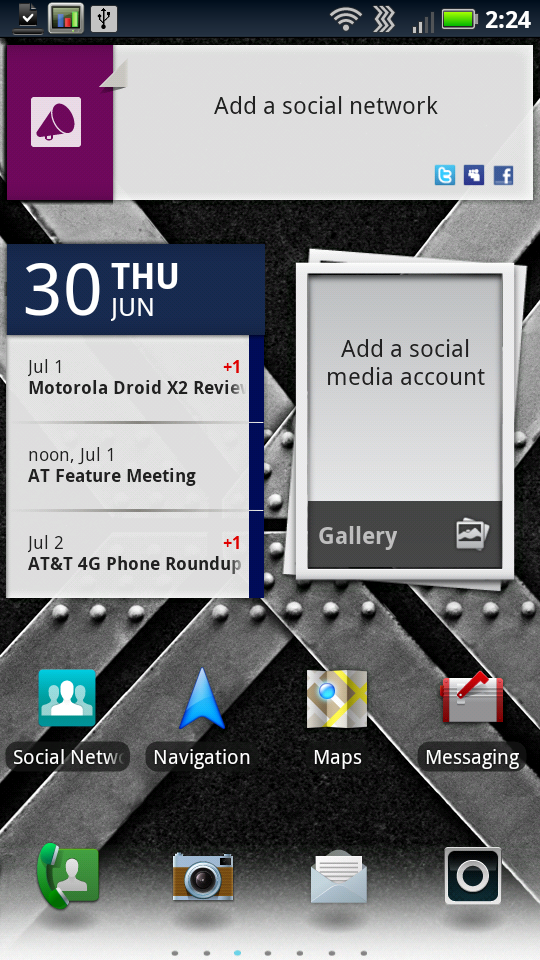
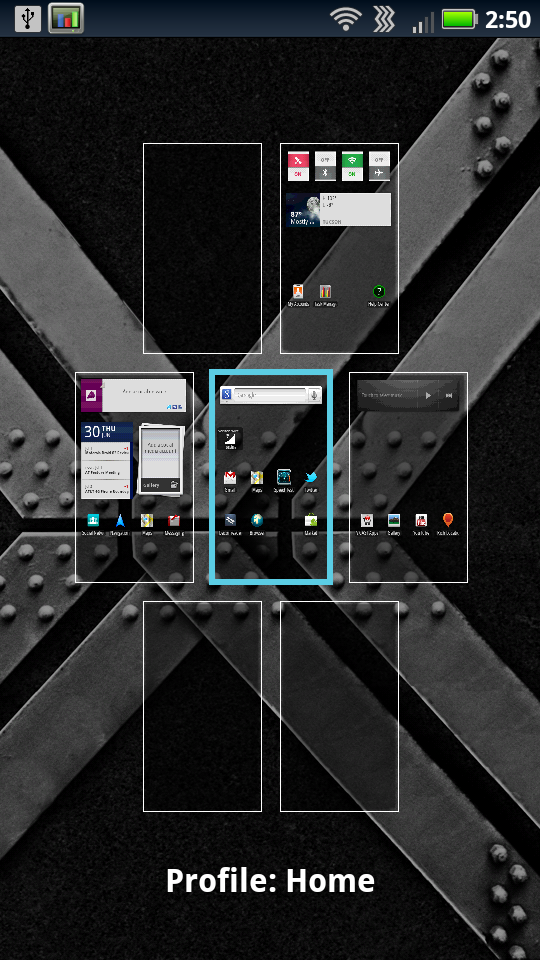
One thing that’s thankfully changed is the homescreen switcher. Previously, swiping from one homescreen to another would bring up a bottom panel with a bunch of dots. The problem was that this would sit there for a second or so and then go away, but often times after switching homescreens one would want to tap on the application launcher icon. It looked like this:
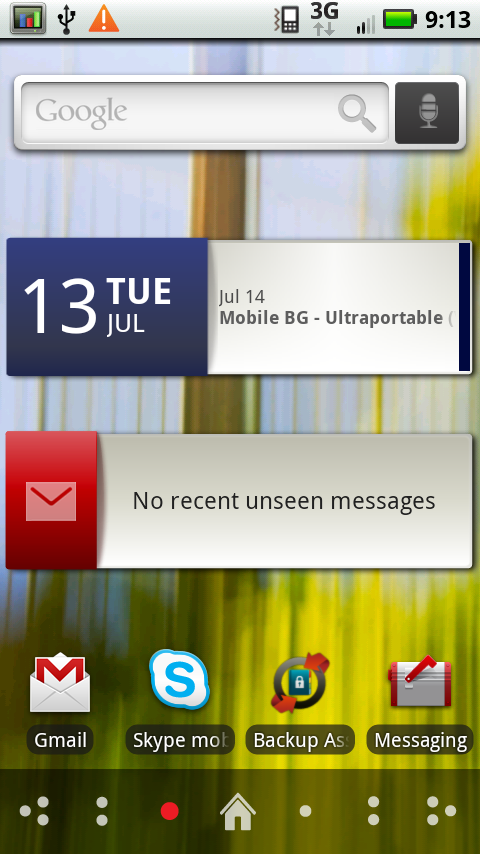
Thank goodness this is changed now. Instead, we get dots that turn blue depending on what homescreen is active, and no obscuration of that app launcher button. Thank goodness.
Hit the application launcher and you get a four icon wide grid of apps that scrolls up and down. This is pretty standard fare, and relatively smooth. Tapping on the top left corner brings up a menu that lets you switch the sorting from all, to recent, to downloaded. You can also optionally make your own and then add applications to it.
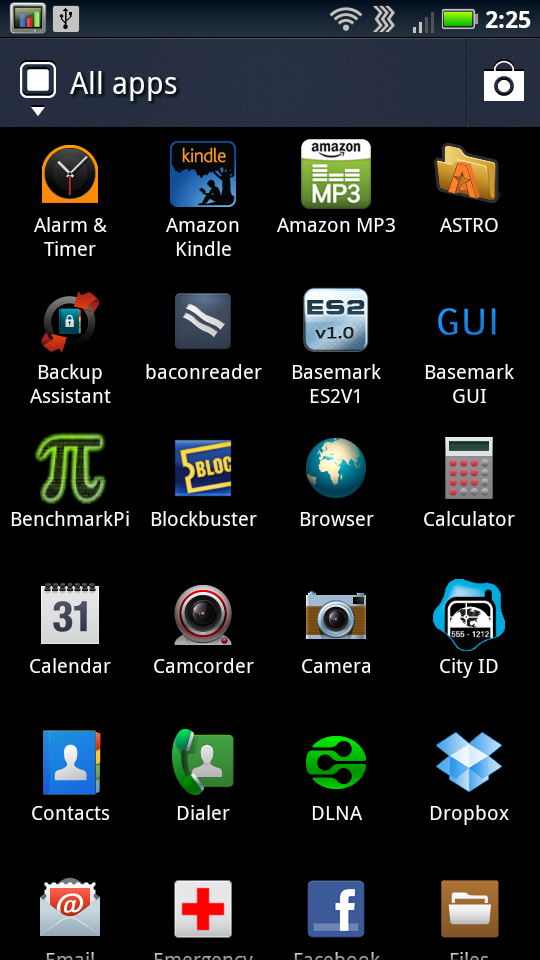
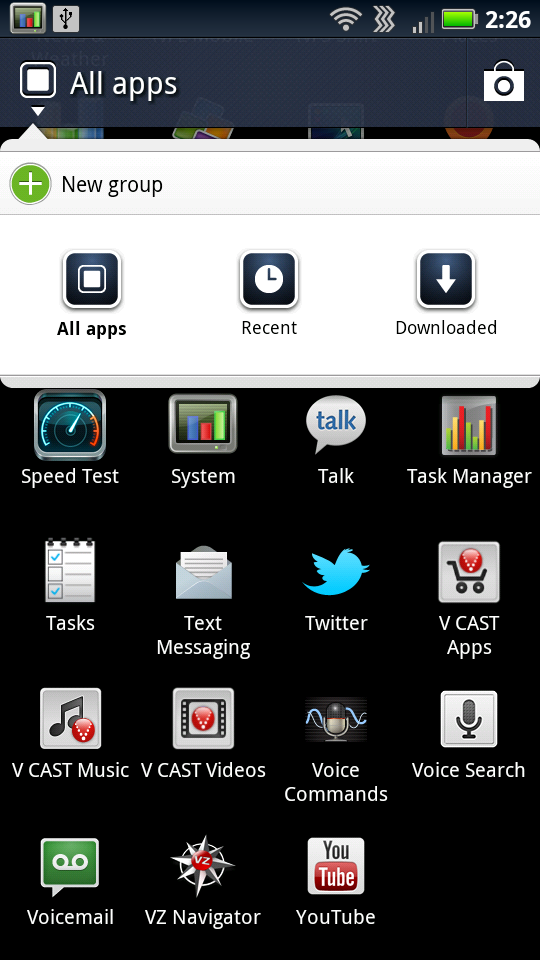
The application switcher (toggled by holding the home button) does a clever trick. Instead of bringing up a real switcher, it simply is a shortcut to the recent list of applications.
The final Motoblur customization is of course account management. Ideally, Motorola wants you to configure and log into all your social media accounts using their software, and then their widgets and special unified messaging application will populate accordingly. It’s great, and I’m sure it works for some people, but it still isn’t something for me. It’s better to just get the first party through each service’s respective application at this point.
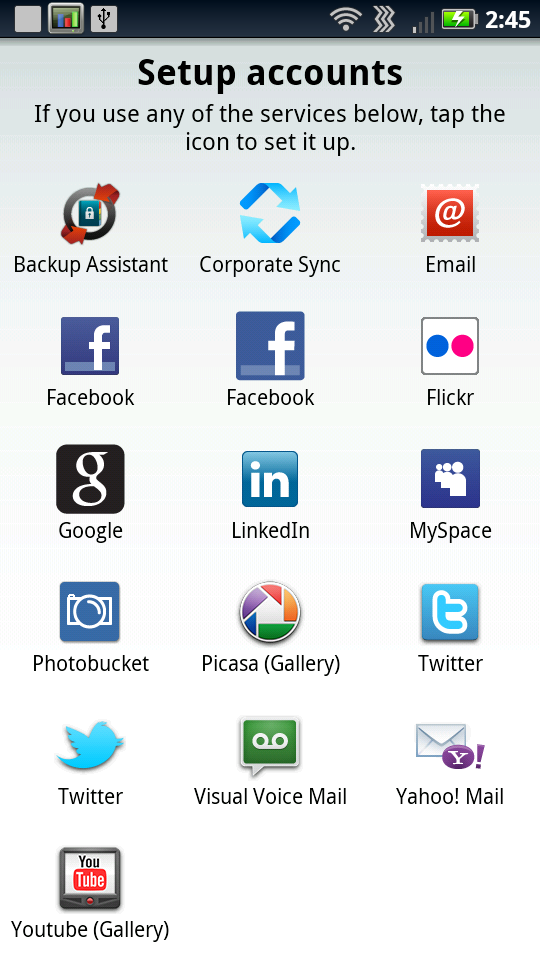
All of that basically sums up Motoblur, which superficially just makes Android look different. Love it or hate it, it’s still here and will likely stay around for some time. It made it onto Android 2.3 on the X, and will likely do the same with the X2. There’s no way to remove it either without flashing another ROM, and at this point the X2 still has a locked bootloader (no fastboot oem unlock, trust me, I tried), so if you want to be rid of it (or install a custom ROM) you could be waiting a while.
I should note that the X2 doesn't have the even newer version of Motoblur which we've seen running atop leaked photos of the Bionic or Droid 3 as of this writing. That hopefully will come at some point in the future - or maybe not in retrospect, depending on how you feel about that version of the UI skin.
Preloaded Bloat
The X2 also comes with a bunch of preloaded applications, but no more than I’ve become used to seeing on other devices in Verizon’s smartphone lineup. That includes Amazon MP3, Blockbuster, City ID, Lets Golf 2, NFL Mobile, NFS Shift, Slacker, and four Verizon applications.
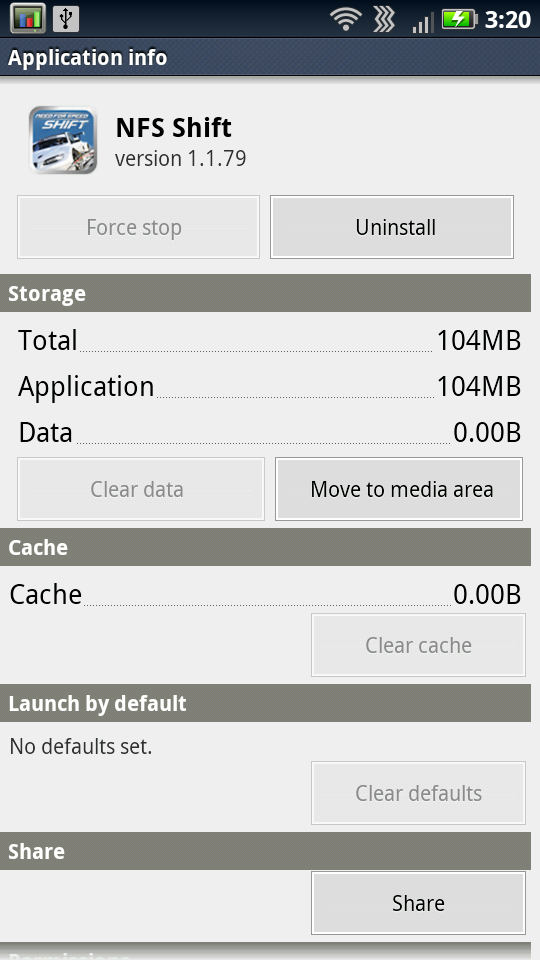

However, the good news is that you can finally uninstall some of this stuff. I successfully nuked Lets Golf, NFL Mobile, and NFS Shift. However, things like Blockbuster and the Verizon apps cannot be removed. Slowly but surely, we’re getting to the point where users can actually have some control over and remove carrier-preloaded garbage without needing root.










72 Comments
View All Comments
anandatar - Thursday, July 7, 2011 - link
So yeah, I know, Anandtech is a US blog.Still I'm surprised there is no comparison to the Galaxy S 2 - I was already surprised before by this but nothing has changed.
The main reason is because ALL the phones in the comparison look pale when compared with the S2.
It's (much) faster than any of the Tegra2 based devices.
It has more ram.
It's (much) lighter (there's no xperia either)
It's (much) thinner (there's no xperia either)
it's camera still picture is second to the N8 only
it's camera video recordings are above average (not blowing others out of the water tho - in 1080p it's zoomed and focusing is slower - in 720p its awesome)
it's battery life is (much) improved too
in fact, on the paper, only the resolution (800x480) is lower than the other phones (that sometimes have qHD)
Not only that, but it's also the first phone I'd use instead of an iPhone - it's that much better that it makes sense to switch. But I wouldnt settle for less.
jmcb - Thursday, July 7, 2011 - link
Glad you like the GS2 so much....If you know all this, why do you need to see a comparison? Check other sites, they do compare the GS2 with other phones...Imma help you out.... phonearena is one site that does. phonedog is another...
NeoteriX - Thursday, July 7, 2011 - link
You mentioned in your HTC Sensation review that with a little digging, you were able to come up with the camera sensor used there -- "Samsung’s 8 MP S5K3H1GX 1/3.2” 3264x2488 CMOS sensor with 1.4 µm square pixels "Though the sensor isn't the only thing as you mentioned (lens, etc.), it's useful to compare stated sensitivities, pixel sizes, etc. across the different current phones as well as generationally. I still feel like the gold standard is the iPhone 4 with its 1.75 µm pixel sites and BSI Omnivision sensor.
Do you have this information for the Droid X and X2? How does one generally determine this? I'd love to be able to figure it out for my Evo 3D.
munky - Thursday, July 7, 2011 - link
Iphone4 is by no means the gold standard. Also, there's plenty of variables affecting sensor performance which wouldn't be obvious just by looking at pixel pitch, not to mention how the image processing algorithms affect the final outcome. Unless you suggest AT start evaluating sensors with RAW data a la dxomark, I'd much rather they focus on comparing actual photos as opposed to numerical specs.NeoteriX - Thursday, July 7, 2011 - link
I agree that specs aren't the whole picture, but I do think it provides useful insight to augment the results one sees in practical testing -- things like being able to tell how much of the improvement is image processing, what generation the sensor is and recently of development, and seeing if improving the image quality/sensors used is actually a priority for certain manufacturers. More information never hurts and it helps understand the story -- for example, when digital cameras were undergoing the megapixel race one or two years ago, it was clear that low light quality was degrading and pixel sites helped explain that story.At any rate, I'm no expert on the state of cellphone cameras, but I will respectfully disagree with you on the iPhone 4 -- no other non-camera-phone smartphone (i.e., the Sony/Nokia/etc. type phones with real digital camera level optics and sensors built in, xenon-flashes the whole 9 yards) *I've seen* has the kind of low-light sensitivity and all-around flexibility of the iPhone 4.
It's likely a combination of the relatively large sensor sites, the large fixed aperture of the lens, the BSI CMOS design, and good image processing, but Android mfrs still have their work cut out for them over a year after the iPhone 4 release -- I'd be interested in hearing what other phone is better in low-light and all-around capability, because I certainly haven't seen it.
Exodite - Thursday, July 7, 2011 - link
The new Xperia series (arc/neo/pro/play) seems a good fit, especially considering that the iPhone 5 is slated to use the same sensor as those handsets.Anyway the criteria you use for comparison are rather humorous, as it reads like the iPhone 4 having the best camera - as long as you disregard those that are better?
HTC is generally known to ship shitty cameras but I'd say both foo, bar, beep and bloop - to name those at the top of my mind - offer some excellent solutions for those who want decent images from their smartphones.
(As a side note to Anandtech - your spam filter sucks! Horribly.)
Exodite - Thursday, July 7, 2011 - link
Feel free to replace foo, bar, beep and bloop with the names of big smartphone manufacturers that aren't HTC.I would do it myself, if that wouldn't mean getting caught in the spam filter.
NeoteriX - Thursday, July 7, 2011 - link
That's fair although I wouldn't call my criteria bogus ;)The vast majority of cell/smartphones are those built around sensor/lens/IC SOCs primarily built for mobile applications, they feature LED-based flashes--in essence, they are known to be significant compromises in the world of digital imaging because they are, in other words, phones first, cameras second.
Then, there is a small minority of cell phones that are essentially cameras with phones attached to them -- SonyEricsson C-902, Nokia N82, etc. that feature sensors and lenses pulled from traditional cameras, but with phone functionality -- we're talking about large sensors, camera glass, and xenon flashes intended for P&S digital camera applications and not mobile.
I've heard good things about the new Xperia Arc with the Exmor R BSI sensor, but it hasn't been released in the US yet and neither has the iPhone 5... thus my position that the iPhone 4 leads the pack.
Exodite - Thursday, July 7, 2011 - link
I would say my arc does decent pictures, though perhaps I'm spoiled by the fact that my better half uses a Nokia N8. Color accuracy is good but the focus area is unfortunately very narrow which makes the pictures less good than they could be.The Samsung Galaxy S2 is arguably better, end results considered.
Anyway, I hope the iPhone 5 does end up using the same sensor as the Xperia line as it'd be interesting to see what a different hard/software solution would do with the same sensor.
Then there's stuff like the Motorola Milestone which also have a great camera, considering.
Would an N8 qualify, or is that too a camera first?
Because from my standpoint I can see something like the Altek Leo being a camera first and phone second but I'd still consider anything in a normal housing to be a phone first.
munky - Thursday, July 7, 2011 - link
Have you seen the photos taken with the Nokia N8? They are cleaner that those from iphone4, not to mention more natural looking due to lack of over-sharpening and over-saturation. The iphone4 may be good compared to a crappy phonecam, but it is definitely not the best.